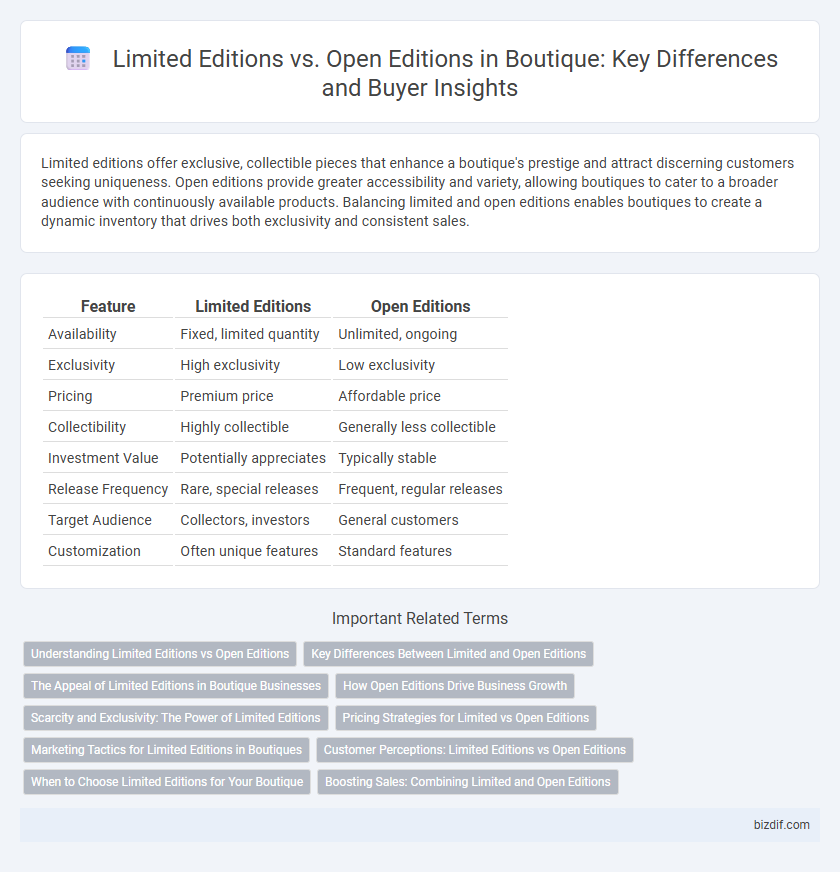Limited editions offer exclusive, collectible pieces that enhance a boutique's prestige and attract discerning customers seeking uniqueness. Open editions provide greater accessibility and variety, allowing boutiques to cater to a broader audience with continuously available products. Balancing limited and open editions enables boutiques to create a dynamic inventory that drives both exclusivity and consistent sales.
Table of Comparison
| Feature | Limited Editions | Open Editions |
|---|---|---|
| Availability | Fixed, limited quantity | Unlimited, ongoing |
| Exclusivity | High exclusivity | Low exclusivity |
| Pricing | Premium price | Affordable price |
| Collectibility | Highly collectible | Generally less collectible |
| Investment Value | Potentially appreciates | Typically stable |
| Release Frequency | Rare, special releases | Frequent, regular releases |
| Target Audience | Collectors, investors | General customers |
| Customization | Often unique features | Standard features |
Understanding Limited Editions vs Open Editions
Limited editions in boutique collections offer exclusivity by producing a fixed number of items, often enhancing rarity and value for collectors. Open editions allow unlimited production, focusing on accessibility and broader availability while maintaining consistent quality and design. Understanding these distinctions helps customers make informed decisions based on exclusivity preferences and budget considerations.
Key Differences Between Limited and Open Editions
Limited editions feature a fixed number of items, creating scarcity and higher collectible value, while open editions have no production limit, allowing unlimited availability. Limited editions often include numbered certificates, enhancing authenticity and exclusivity, whereas open editions prioritize accessibility and affordability. Pricing tends to be higher for limited editions due to rarity, whereas open editions maintain lower prices for broader consumer reach.
The Appeal of Limited Editions in Boutique Businesses
Limited editions create a sense of exclusivity and urgency that drives customer demand in boutique businesses. By offering a finite number of unique items, boutiques enhance perceived value and foster brand loyalty among discerning shoppers. This scarcity marketing strategy often results in higher price points and increased customer engagement compared to open editions.
How Open Editions Drive Business Growth
Open editions increase product availability and foster continuous customer engagement, enabling boutiques to generate steady revenue streams without the constraints of scarcity. These editions allow for flexible inventory management and respond rapidly to market demand, enhancing sales volume and customer loyalty. By offering accessible pricing and unlimited quantities, boutiques expand their customer base and create opportunities for recurring purchases.
Scarcity and Exclusivity: The Power of Limited Editions
Limited editions create scarcity by capping the number of items available, enhancing a boutique's exclusivity and desirability. This scarcity drives higher perceived value and collector interest, often leading to increased demand and premium pricing. Open editions lack this limitation, making limited editions a powerful tool for brand differentiation and customer loyalty in boutique markets.
Pricing Strategies for Limited vs Open Editions
Limited editions command higher prices due to their scarcity and exclusivity, attracting collectors who value rarity and potential investment appreciation. Open editions offer lower price points, appealing to a broader audience and driving volume sales through accessibility and affordability. Effective pricing strategies balance exclusivity for limited editions with mass-market demand for open editions, maximizing revenue across diverse customer segments.
Marketing Tactics for Limited Editions in Boutiques
Limited editions in boutiques leverage scarcity marketing, creating urgency that drives quick purchases and enhances perceived value. Exclusive packaging and personalized customer experiences amplify desirability and brand loyalty. Collaborations with artists or influencers increase exclusivity, aligning the limited edition with niche markets and boosting social media buzz.
Customer Perceptions: Limited Editions vs Open Editions
Customers often perceive limited editions as more exclusive and valuable due to their scarcity, which can drive a sense of urgency and higher demand. Open editions are viewed as more accessible and affordable, appealing to a broader audience seeking quality without exclusivity. This perception influences purchase decisions, with collectors gravitating towards limited editions and casual buyers favoring open editions.
When to Choose Limited Editions for Your Boutique
Limited editions are ideal for boutiques seeking to create exclusivity and drive urgency among customers by offering a finite number of unique products. This strategy works best when targeting collectors or niche markets that value rarity and are willing to pay a premium for exclusivity. Choosing limited editions helps boutiques enhance brand prestige and encourages repeat visits as customers anticipate rare drops.
Boosting Sales: Combining Limited and Open Editions
Combining limited editions with open editions strategically boosts boutique sales by creating urgency and accessibility simultaneously. Limited editions offer exclusivity and higher perceived value, driving quick purchases from collectors and enthusiasts. Open editions maintain steady revenue streams by catering to a broader customer base, ensuring continuous product availability and brand engagement.
Limited Editions vs Open Editions Infographic

 bizdif.com
bizdif.com